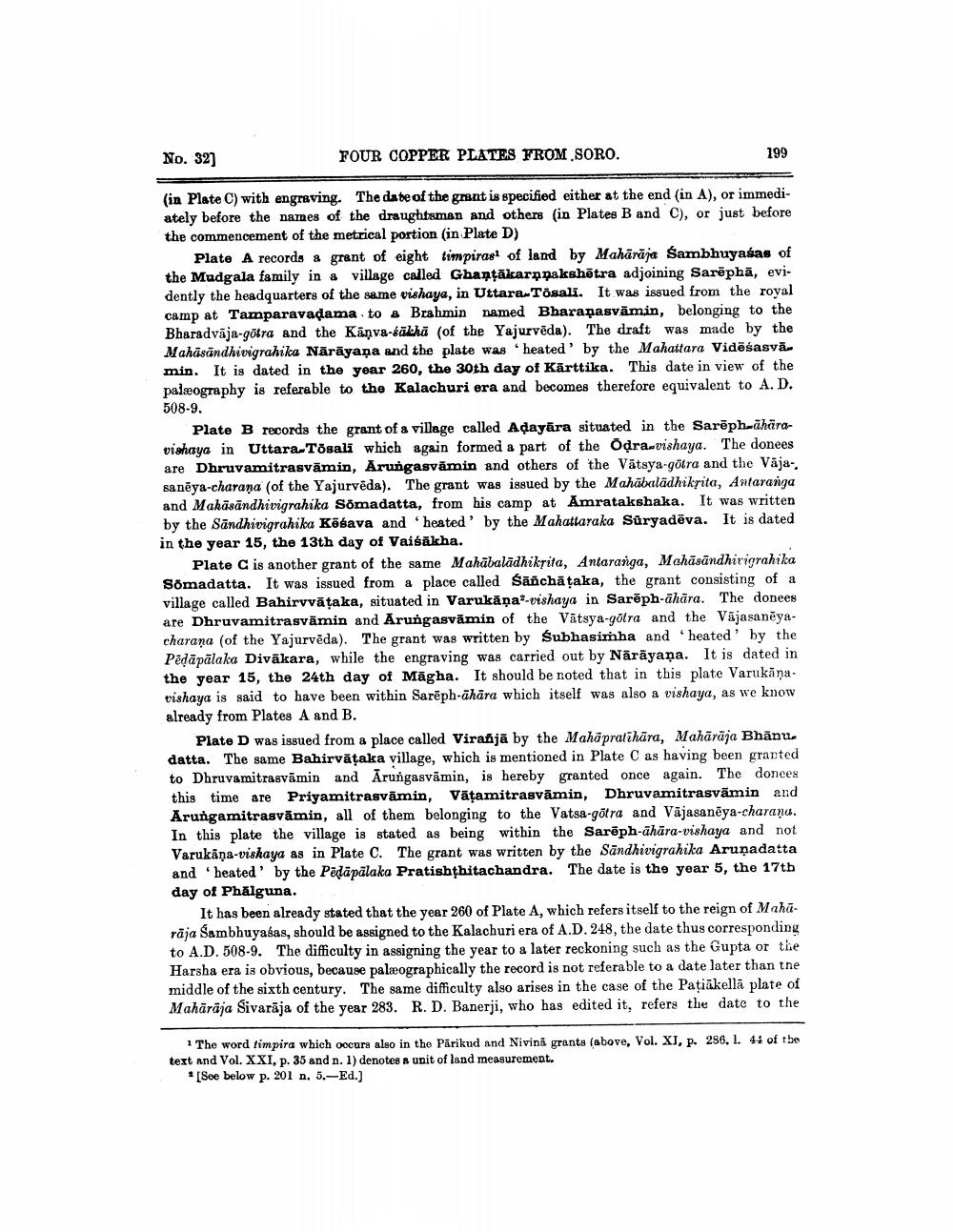________________
No. 32)
FOUR COPPER PLATES FROM SORO.
199
(in Plate C) with engraving. The date of the grant is specified either at the end (in A), or immediately before the names of the draughtsman and others (in Plates B and C), or just before the commencement of the metrical portion (in Plate D)
Plate A records a grant of eight timpirasl of land by Mahārāja Sambhuyasas of the Mudgala family in a village called Ghanțăkarppakshētra adjoining Sarēphā, evidently the headquarters of the same vishaya, in Uttara.Tösali. It was issued from the royal camp at Tamparavadama to a Brahmin named Bharapasvämin, belonging to the Bharadvāja-götra and the Kāņva-sākha (of the Yajurvēda). The draft was made by the Mahāsāndhevigrahika Nārāyaṇa and the plate was heated' by the Mahaitara Vidēśasyā. min. It is dated in the year 260, the 30th day of Kārttika. This date in view of the palæography is referable to the Kalachuri era and becomes therefore equivalent to A. D. 508-9.
Plate B records the grant of a village called Adayāra situated in the Sarēph-āhāravishaya in Uttara.Tosali which again formed a part of the Odra.vishaya. The donees are Dhruvamitrasvāmin, Arungasvāmin and others of the Vätsya-gotra and the Vāja, saněya-charana (of the Yajurvēda). The grant was issued by the Mahābalādhikrita, Antaranga and Makäsāndhivigrahika Somadatta, from his camp at Amratakshaka. It was written by the Sāndhivigrahika Köbava and heated by the Mahattaraka Süryadēva. It is dated in the year 15, the 13th day of Vaisakha.
Plate C is another grant of the same Mahābalādhikrita, Antaranga, Mchāsāndhirigrahika Sömadatta. It was issued from a place called Śāñchāțaka, the grant consisting of a village called Bahirvvāțaka, situated in Varukāņa - vishaya in Sarēph-āhāra. The donees are Dhruvamitrasvāmin and Arungasvāmin of the Vätsya-götra and the Vājasaneyacharana (of the Yajurvēda). The grant was written by Subhasimha and heated by the Pēdāpālaka Divākara, while the engraving was carried out by Nārāyaṇa. It is dated in the year 15, the 24th day of Māgha. It should be noted that in this plate Varukānavishaya is said to have been within Sarēph-āhāra which itself was also a vishaya, as we know already from Plates A and B.
Plate D was issued from a place called Virañjā by the Mahapratihāra, Mahārāja Bhānu datta. The same Bahirvātaka village, which is mentioned in Plate C as having been granted to Dhruvamitrasvāmin and Arungasvāmin, is hereby granted once again. The donees this time are Priyamitrasvāmin, Văţamitrasvāmin, Dhruvamitrasvāmin and Arungamitrasvāmin, all of them belonging to the Vatsa-gõtra and Vājasanēya-charana. In this plate the village is stated as being within the Sarēph-āhāra-vishaya and not Varukāņa-viskaya as in Plate C. The grant was written by the Sāndhivigrahika Aruņadatta and heated by the Pēdāpālaka Pratishthitachandra. The date is the year 5, the 17th day of Phālguna.
It has been already stated that the year 260 of Plate A, which refers itself to the reign of Maharāja Sambhuyasas, should be assigned to the Kalachuri era of A.D. 248, the date thus corresponding to A.D. 508-9. The difficulty in assigning the year to a later reckoning such as the Gupta or the Harsha era is obvious, because palæographically the record is not referable to a date later than the middle of the sixth century. The same difficulty also arises in the case of the Pațiākellā plate of Mahārāja Sivarāja of the year 283. R. D. Banerji, who has edited it, refers the date to the
1 The word timpira which occurs also in the Parikud and Nivina grants (above, Vol. XI, p. 286. 1. 41 of the text and Vol. XXI, p. 35 and n. 1) denotes a unit of land measurement.
*[Soe below p. 201 n. 5.-Ed.)




